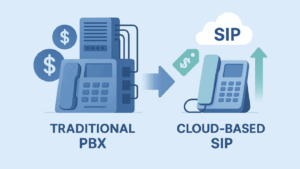
Step-by-Step Guide to Migrating to SIP Trunking
Quick Guide to Migrating to SIP Trunking:
– Step 1: Audit current system and network capacity.
– Step 2: Partner with a quality SIP provider.
– Step 3: Plan the installation with minimal business disturbance.
– Step 4: Thoroughly test the new SIP system.
– Step 5: Go live and continuously monitor.
Are you tired of dealing with outdated communication systems that limit your business flexibility and rack up high costs? Modernizing your business communications is no longer just an option; it’s a necessity. The shift from traditional ISDN services to SIP trunking represents a significant leap forward, offering unmatched flexibility, lower costs, and enhanced integration capabilities, especially for small to medium-sized businesses aiming for growth.
Understanding SIP trunking and its importance is the first step towards modernizing your communications. It’s not just about keeping up with technology trends; it’s about providing your business with the tools it needs to thrive in today’s digital landscape. Migrating to SIP can seem daunting, but with the right preparation and guidance, it can be a smooth transition.
Consider this: SIP trunking not only reduces your monthly phone bills but also scales effortlessly with your business needs. Unlike traditional phone lines, SIP trunking enables you to easily adjust the number of channels to match your call volume, ensuring you only pay for what you use and can seamlessly integrate with platforms like Microsoft Teams for a unified communication strategy.
Keep reading for a step-by-step guide on how to make this shift efficiently, addressing key considerations from assessing your current infrastructure to choosing the right SIP provider and finally, making the leap without missing a beat in your day-to-day operations.

Explore more about SIP Trunking and its transformative impact on business communications through resources like VoIP-info for a deeper understanding of network readiness and OnSIP’s guide for pre-migration testing.
Understanding SIP Trunking
Transitioning to SIP Trunking is like upgrading from a flip phone to a smartphone. It’s all about making your business communication smarter, faster, and more cost-effective. Let’s break it down.
What is SIP Trunking?
At its core, SIP Trunking uses the internet to connect your phone system. SIP stands for Session Initiation Protocol. In simple terms, it’s the tech talk that lets you make voice and video calls over the internet. Instead of using physical wires (like old-school phone lines), SIP Trunking moves everything online. For a detailed look, check out What is SIP? on VoIP-info.
Benefits of SIP Trunking
Switching to SIP Trunking brings a bunch of perks:
- Cost Savings: Say goodbye to expensive traditional phone lines. With SIP, you only pay for what you need.
- Scalability: Need more lines? Add them instantly without waiting for new physical installations.
- Flexibility: Work from anywhere. SIP Trunking isn’t tied to a location, making remote work a breeze.
- Reliability: Modern SIP solutions offer robust features like failover options, ensuring your communications stay up and running.
SIP vs. PRI
PRI (Primary Rate Interface) is like the VHS tape of business communication. It’s been around for ages, providing multiple lines over a single physical connection. But it’s inflexible and can be costly.
Comparing the two:
- Scalability: SIP wins. Add lines as you need them, without physical limitations.
- Cost: SIP often comes out cheaper, with lower setup and call costs.
- Flexibility: SIP allows for easy integration with modern business tools and remote work setups.
For businesses looking to modernize their communications, SIP Trunking is a clear choice. It offers the flexibility, scalability, and cost savings that modern businesses need to thrive.
To dive deeper into the benefits and setup process, SIP.US’s Ultimate Guide to Business Trunking provides an excellent resource for businesses considering the switch.
The move to SIP is not just about saving costs or adding lines; it’s about setting your business up for future growth and agility. With the right partner and a clear understanding of SIP Trunking, your business can embrace the future of communication with confidence.
Preparing for SIP Trunking Migration
Welcome to the journey towards modernizing your business communications! This guide is crafted for small to medium-sized businesses looking to make a smooth transition to SIP Trunking. Let’s dive into how you can prepare effectively for this significant leap.
Assessing Current Infrastructure
Audit Current System: Before anything else, take a comprehensive inventory of your current telephony system. This includes understanding the types of devices in use, the existing phone lines, and any other communication tools your business relies on. It’s crucial to identify what can be retained and what needs an upgrade to support SIP Trunking.
Evaluate Architecture: Next, assess the architecture of your current setup. This involves understanding how your calls are processed and routed. Do you have a centralized system, or is it distributed across multiple locations? This evaluation will help in designing a more streamlined and efficient SIP Trunking architecture.
Network Capacity: SIP Trunking relies heavily on your internet bandwidth. It’s essential to ensure that your current network can handle the additional load of voice traffic. Conduct a network readiness test to gauge whether you need to upgrade your bandwidth or make other network adjustments.
Choosing the Right SIP Provider
Selecting a SIP provider is a critical decision in your migration journey. Here’s what to consider:
Provider Selection Criteria: Look for a provider that offers robust, high-quality service without locking you into long-term contracts. Flexibility in scaling up or down based on your business needs is key.
Interoperability: Ensure that the SIP provider you choose supports a broad range of hardware and software. This flexibility allows you to integrate SIP Trunking with your existing infrastructure seamlessly.
Reliability: Your communication system is vital to your business operations. Opt for a provider with a proven track record of uptime and reliability. Check for redundancy measures and how they handle network outages.
Security: Voice communications can be vulnerable to security threats. Your chosen SIP provider should have strong security protocols in place to protect your calls and data.
SIP.US Features: At SIP.US, we pride ourselves on our straightforward approach to SIP Trunking. Our features include on-demand scalability, no long-term obligations, extensive DID inventory, and a commitment to security and reliability. Plus, our setup help and ongoing support ensure you’re never alone in your SIP journey.
The right SIP provider is not just a vendor but a partner in your business’s growth and success. With SIP.US, you gain a team dedicated to delivering quality, flexibility, and value, ensuring your transition to SIP Trunking is smooth and beneficial.
In the next sections, we’ll guide you through the migration process step by step, addressing common concerns and highlighting cost considerations. Stay tuned to empower your business communication with SIP Trunking.
The Migration Process
Embarking on a journey to modernize your communication with SIP Trunking can be a game-changer for your business. It’s all about planning smart, installing efficiently, and testing thoroughly. Let’s dive into how we can make this transition seamless for you.
Step One: Scoping the Job
First things first, let’s talk about what your move to SIP Trunking will look like. Together, we’ll explore whether your business is suited for a big switch all at once, or if it’s better to transition gradually. This might mean moving over branch by branch, or even floor by floor. The beauty of SIP Trunking is its ability to work right alongside your existing ISDN system, so there’s no need to worry about disruptions.
We’ll also discuss costs upfront, so there are no surprises down the line. Our goal is to make this step as smooth as possible, with minimal disturbance to your day-to-day operations.
Step Two: Auditing the Current System
Next up, we’ll take a close look at your current setup. This means auditing your infrastructure and network capacity to ensure we tailor our SIP service to meet your business’s unique demands. This step is crucial for understanding what bandwidth is available and whether additional connections are needed to handle voice traffic. It’s a thorough process, but it’s key to a successful migration. Ready to test your network’s readiness? Start with this Network Readiness Test.
Step Three: Installing the New System
With planning and auditing out of the way, it’s time to start the installation. SIP Trunking is less bulky than ISDN in terms of infrastructure, meaning you’ll notice a significant reduction in on-site equipment. And since SIP can run alongside ISDN, your business operations can continue as usual, without any hitches during this phase.
Step Four: Testing and Checking
Before we go live, we’ll run extensive tests to ensure everything is working perfectly. This includes making sure the new SIP system integrates seamlessly with your business applications, like Skype for Business, and checking the resilience and business continuity features are up to par. It’s a busy time for IT, but for everyone else, it’ll be business as usual. Want to ensure your setup is ready? Consider a SIP Trunk Testing before the big switch.
Step Five: Going Live
The moment of truth! With all the prep, installation, and testing done, it’s time to activate your new SIP system. If we’ve done our job right (and we always aim to), this step will be smooth sailing. Activation can happen in stages, depending on your initial plan, but rest assured, we’ll be monitoring continuously to ensure everything runs smoothly. For an easy management of your new system, don’t forget to check out the SIP.US Control Panel.
Migrating to SIP Trunking is a journey, but with our guidance, it doesn’t have to be a daunting one. We’re here to ensure that each step is clear, manageable, and beneficial for your business. Ready to take the first step? Let’s collaborate and make your communication system better than ever.
Addressing Common Concerns
When considering a switch to SIP Trunking, several common concerns arise. Let’s address these head-on to help you make an informed decision.
How to Set Up SIP Trunking
Setting up SIP Trunking is simpler than you might think, but it does require attention to detail. Here’s a quick guide:
- Create an Account: First things first, you’ll need an account with a SIP provider, like us at SIP.US.
- Add a SIP Trunk: Log into your PBX system and add a new SIP Trunk. This involves entering your SIP account details and configuring the trunk to connect your system to the outside world.
- Configure the Trunk: Set outbound caller ID, maximum channel capacity, and SIP peer details. This step is crucial for ensuring your calls are routed correctly.
- Check the Trunk Status: Once everything is set up, you’ll want to verify that the trunk is active and functioning as expected. This can usually be done through your PBX system’s interface.
For a deeper dive into these steps, our friends at ExpertIP emphasize the importance of good planning and support from your service provider.
How to Migrate from PRI to SIP
Migrating from PRI to SIP might seem like a big leap, but it’s a strategic move for any business looking to modernize its communication systems. Here’s what the process generally involves:
- Assessing Interoperability: Ensure your current equipment can work with SIP. This may involve updating software or hardware to ensure compatibility.
- Considering a Hosted PBX: This option can eliminate the need for on-site PBX hardware, offering a more flexible and cost-effective solution.
- Understanding Network Ownership: Moving to SIP might change how your network is managed. This is a crucial aspect to consider for maintaining call quality and security.
- Installing a Session Border Controller (SBC): This device ensures secure and efficient communication between your network and your SIP provider. It’s a vital component for any SIP-based system.
For more insights on migrating from PRI to SIP, Atlantech offers a comprehensive guide that covers all the critical factors to consider.
Becoming a SIP Provider
If your ambitions go beyond using SIP Trunks and towards becoming a provider, here’s the essence of what you need to know:
- Use an Upstream Trunk Provider: This approach involves connecting your system to an existing provider’s network, allowing you to offer SIP services without building infrastructure from scratch.
- Implement Traditional Telephone Lines: This could involve integrating multiple POTS lines or an ISDN connection, serving as a bridge to the SIP world.
- Extend the PSTN Network: This method involves a more direct integration with the public switched telephone network, requiring significant infrastructure and investment.
For a deeper understanding, a Reddit user in the r/VOIP community offers valuable insights into the technical and business considerations of offering SIP services.
Migrating to SIP Trunking or becoming a SIP provider offers numerous benefits, including cost savings, increased flexibility, and enhanced functionality. With careful planning, the right support, and a clear understanding of the technical requirements, businesses of all sizes can successfully navigate these changes.
Cost Considerations
When thinking about how to migrate to SIP trunking, it’s crucial to discuss the financial implications. Understanding SIP trunk costs, the predictability of pricing, and conducting a cost-benefit analysis are key steps in ensuring that the move to SIP trunking aligns with your business objectives and budget.
SIP Trunk Costs
The cost of SIP trunking can vary based on several factors, including the number of channels (simultaneous calls) needed, the volume of outbound calls, and any additional features or services. On average, businesses might spend between $15 to $25 monthly per SIP trunk. However, this is often significantly less than traditional phone lines, leading to long-term savings.
Predictable Pricing
One of the advantages of SIP trunking is the element of predictable pricing. Unlike traditional telephony that comes with variable costs based on usage and long-distance charges, SIP trunking providers often offer flat-rate pricing. This makes budgeting for communication expenses more straightforward. At SIP.US, we understand the importance of predictable costs for small to medium-sized businesses. Our plans are designed to be transparent, with no hidden fees, providing peace of mind and allowing for easier financial planning.
Cost-Benefit Analysis
Performing a cost-benefit analysis is crucial before making the switch to SIP trunking. Consider the following:
- Reduced Call Costs: As mentioned, SIP trunking can significantly reduce the cost of long-distance and international calls. Businesses with high call volumes will see substantial savings here.
- Scalability: SIP trunking’s scalable nature means you only pay for what you need. As your business grows, it’s easy to add additional lines or features without significant upfront costs.
- Maintenance Savings: SIP trunking requires less physical infrastructure, which means lower maintenance costs and less potential downtime.
- Enhanced Features: Many SIP trunking plans come with advanced features like auto-attendants, voicemail to email, and call forwarding. While these features can enhance business operations, they also factor into the overall cost-benefit analysis.
By comparing the initial and ongoing costs of SIP trunking against the potential savings and operational benefits, businesses can make an informed decision.
Final Thoughts
The migration to SIP trunking represents not just a shift in technology but a strategic business move towards more efficient, flexible, and cost-effective communication solutions. While the upfront costs and the effort of migration might seem daunting, the long-term benefits and cost savings are significant. Before making the switch, we recommend conducting a thorough cost-benefit analysis, considering both the immediate and ongoing financial implications of SIP trunking for your business.
For more details on our pricing and how we can help your business save money while enhancing communication capabilities, check out our affordable SIP trunking plans.
Frequently Asked Questions about SIP Trunking
In modern communication, SIP trunking has become a key element for businesses seeking flexibility, scalability, and cost efficiency. Here, we answer some of the most common questions about SIP trunking to help you understand how it can benefit your business.
How Much Does SIP Trunk Cost?
When it comes to SIP trunking, one of the first questions many businesses have is about the cost. On average, businesses can expect to pay between $15 to $25 monthly per SIP trunk. The exact cost depends on several factors including the provider, the number of channels (simultaneous call capabilities), and any additional features like Direct Inward Dialing (DID) numbers or e911 services.
While there are initial setup fees, they are generally minimal compared to the cost of installing a traditional telephone system. Plus, with SIP trunking, you often enjoy lower call rates, especially for long-distance and international calls. This makes SIP trunking not just a modern solution but also a cost-effective one for businesses of all sizes.
For specific pricing and plans, we encourage you to check out our SIP trunking plans which are designed to be flexible and affordable, catering to the unique needs of your business.
How to Set Up SIP Trunking?
Setting up SIP trunking is less complicated than you might think, especially with a provider like SIP.US that focuses on making the process as straightforward as possible. Here’s a basic outline of the steps involved:
- Create an Account with a SIP Provider: Start by choosing a reputable SIP trunk provider, like SIP.US, and creating an account.
- Add a SIP Trunk in Your PBX: Configure your PBX system to add a new SIP trunk, using the credentials provided by your SIP provider.
- Configure SIP Trunk Settings: Adjust the settings on your PBX and router to optimize the quality of service (QoS) for SIP calls. This may include setting up DIDs, caller ID, and other features offered by your provider.
- Test the Trunk Status: Before going live, thoroughly test the SIP trunk to ensure it’s working correctly with your PBX system and that call quality meets your standards.
For a more detailed guide on setting up your SIP trunking, you can visit our easy-to-follow tutorials and documentation or reach out to our support team for assistance.
How to Migrate from PRI to SIP?
Migrating from PRI to SIP can seem daunting, but with careful planning and the right partner, the transition can be smooth and beneficial for your business. Here are the key steps to consider:
- Assess Interoperability: Ensure your current phone system and equipment are compatible with SIP technology. Most modern systems are, but it’s crucial to check.
- Choose a Hosted PBX or SIP Trunking: Depending on your business needs, you might opt for a fully hosted PBX solution or SIP trunking for your existing PBX system.
- Plan for Network Ownership: Ensure your network is ready for SIP with the necessary bandwidth and Quality of Service configurations to handle your call volume.
- Consider the Use of a Session Border Controller (SBC): An SBC can help manage traffic, enhance security, and ensure compatibility between different networks and protocols.
- Test Before Full Migration: Run a parallel operation of both PRI and SIP during a transition phase, allowing you to iron out any issues before completely phasing out PRI.
For a seamless migration from PRI to SIP, partnering with an experienced provider like SIP.US can make all the difference. Our team can guide you through each step, ensuring a smooth transition with minimal disruption to your business operations.
By embracing SIP trunking, you’re not just upgrading your communication system; you’re also setting your business up for future growth and innovation. For more information on how to make the switch, or to start your migration journey, visit SIP.US.
Conclusion
- Embracing SIP Trunking, Future-Proofing Communications, SIP.US Benefits
Making the move to SIP trunking is like giving your business a key to the future. It’s not just about saving costs or adding lines; it’s about unlocking a new level of flexibility, reliability, and efficiency in your communications. At SIP.US, we understand the importance of being more than just a service provider. We’re your partner in transforming the way your business connects, communicates, and thrives in the digital age.
Embracing SIP trunking means you’re ready to:
– Scale efficiently, adding or removing lines as your business needs change, without waiting for physical installations.
– Enjoy unparalleled flexibility, with connections that aren’t tied to a physical location, empowering your team to work remotely with ease.
– Cut down on costs, not just in terms of monthly bills, but also by reducing the need for on-site maintenance and management.
– Future-proof your communication systems, ensuring your business can adapt to new technologies and opportunities as they arise.
We’ve seen the transformation that businesses undergo when they switch to SIP trunking — from enhanced productivity to significant cost savings. And with our easy-to-use control panel, predictable pricing, and fast setup, the transition is smoother and more straightforward than you might think.
At SIP.US, we’re not just offering a service; we’re offering a way to revolutionize your business communications. With our SIP trunking plans, you’re not just preparing for the future; you’re shaping it. Let’s embrace this journey together, ensuring that your business communication is not just up-to-date but also prepared for whatever the future holds.
For further reading and to explore how our services can benefit specific aspects of your business, please visit our Features page for detailed information on what SIP.US can offer you.
The future of business communication isn’t just about keeping up with technology; it’s about leveraging it to create value for your customers and opportunities for your business. Let SIP.US help you unlock that potential.



